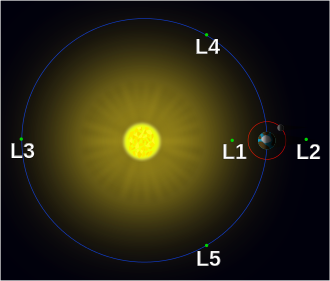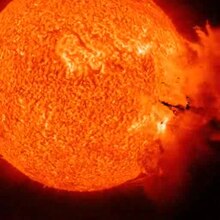Vigil (spacecraft)
| Names | Lagrange |
|---|---|
| Mission type | Space weather forecast |
| Operator | ESA |
| Start of mission | |
| Launch date | Mid 2020s (planned) |
| Rocket | L1: Vega C[1] L5: Ariane 6.2[1] |
Vigil, formerly known as Lagrange, is a planned solar weather mission by the European Space Agency (ESA). It envisions two spacecraft to be positioned at Lagrangian points L1 and L5.[2][3][4][1]
Monitoring space weather includes events such as solar flares, coronal mass ejections, geomagnetic storms, solar proton events, etc.[4] Monitoring would help predict arrival times at the Earth and any potential effect on infrastructure. The Vigil spacecraft are anticipated to launch in the mid 2020s.[5]
On 17 May 2021, ESA began soliciting design concept studies from various European industrial and scientific consortiums for the mission. A final design will be selected after approximately 18 months, in late 2022.[6] Simultaneously, the ESA announced the No-Name Mission contest to replace the placeholder Lagrange name.[7] The winning name, Vigil, was announced on 10 February 2022.[8]
Overview[]

To ensure an effective capability to monitor potentially dangerous solar events, ESA initiated a study of two potential future space weather satellites called Lagrange.[3] The Lagrange mission concept is overseen by the Space Situational Awareness Programme at ESA. On 2 February 2018, ESA signed technological contracts (Phase A) to be led by Airbus UK and OHB SE of Germany to design the spacecraft specifications and the instruments' integration process.[2] UK's Rutherford Appleton Laboratory and Mullard Space Science Laboratory will assess the requirements of the science payload.
This mission concept proposes positioning two spacecraft in orbit at the L1 and L5 Lagrangian points, respectively, where gravitational forces interact to create a stable location to save propellant and from which to make observations. L1 is in the solar wind 'upstream' from Earth, so measurements at L1 provide information about the space weather coming toward Earth. In contrast, the L5 point provides a way to monitor coronal mass ejections (CMEs) from the 'side' in order to estimate their speed and direction.[4]
Objectives[]
| Heliophysics |
|---|
| Phenomena |
The preliminary mission objectives are:[4]
- the spacecraft at L1 is to provide observations of the solar wind speed, density, temperature and dynamic pressure, charged particle environment and the direction and strength of the interplanetary magnetic field.
- The spacecraft at L1 would also monitor the solar disk and solar corona and measure solar energetic particles that may be associated with solar flares and the onset of coronal mass ejections.
- The spacecraft at L5 would complement measurements made from L1 by providing a side-view of the propagation of plasma clouds emitted by the Sun toward Earth.
- The spacecraft at L5 would monitor of the solar disk and corona and carry out measurements of the interplanetary medium.
Payload[]
To achieve these objectives, the satellites at the L1 and L5 positions have to carry different types of remote-sensing and in-situ instruments. The suggested optical instruments take heritage from ESA and NASA science missions like SOHO, STEREO and Solar Orbiter, but the instruments would be optimized for operational space weather monitoring.[1] The notional science payload may require:[4][1]
- Optical instruments
- Coronagraph – for onset and characterisation of coronal mass ejections (CMEs).
- Heliospheric imager (HI) – A wide-angle visible-light imaging system for the detection of coronal mass ejection events directed toward Earth.
- Magnetograph - would scan a selected solar spectrum to generate 3D maps of the magnetic field.
- EUV imager – Imaging of the complex solar corona (the Sun's atmosphere) will support monitoring of the magnetic complexity and activity in the corona and location of the flaring active regions.
- X-ray flux monitor – Detection of solar flares and quantification of the flare energy.
- In situ instruments
- Magnetometer – Measurement of the interplanetary magnetic field.
- Plasma analyser – To measure angular velocity components of the solar wind approaching the Earth and estimates of geomagnetic storm strength.
- Radiation monitor – Monitoring radiation storms (Solar particle event) is crucial, as these can disrupt and damage spacecraft, aircraft and ground systems.
- Medium energy particle spectrometer – This can monitor clouds of medium-to-low energy ions approaching the Earth.
References[]
- ^ a b c d e Remote sensing optical instrumentation for enhanced space weather monitoring from the L1 and L5 Lagrange points. (PDF). S. Kraft; K. G. Puschmann; J. P. Luntama. Proceedings Volume 10562, International Conference on Space Optics — ICSO 2016; 105620F (2017); doi:10.1117/12.2296100. International Conference on Space Optics — ICSO 2016, 2016, Biarritz, France.
- ^ a b Design call for 'solar sentinel' mission. Jonathan Amos, BBC News. 2 February 2018.
- ^ a b Future Lagrange Mission. European Space Agency (ESA). 10 November 2017.
- ^ a b c d e Monitoring space weather. European Space Agency (ESA). 4 December 2017.
- ^ "Vigil". ESA. 10 February 2022. Retrieved 10 February 2022.
- ^ "The "no name" space weather mission". ESA. 17 May 2021. Retrieved 18 May 2021.
- ^ "Name ESA's new mission!". ESA. 17 May 2021. Retrieved 18 May 2021.
- ^ "Introducing ESA Vigil: Earth's devoted solar defender". ESA. 10 February 2022. Retrieved 10 February 2022.
- Proposed space probes
- 2020s in spaceflight
- Missions to the Sun
- European Space Agency space probes
- Solar space observatories
- Solar telescopes



